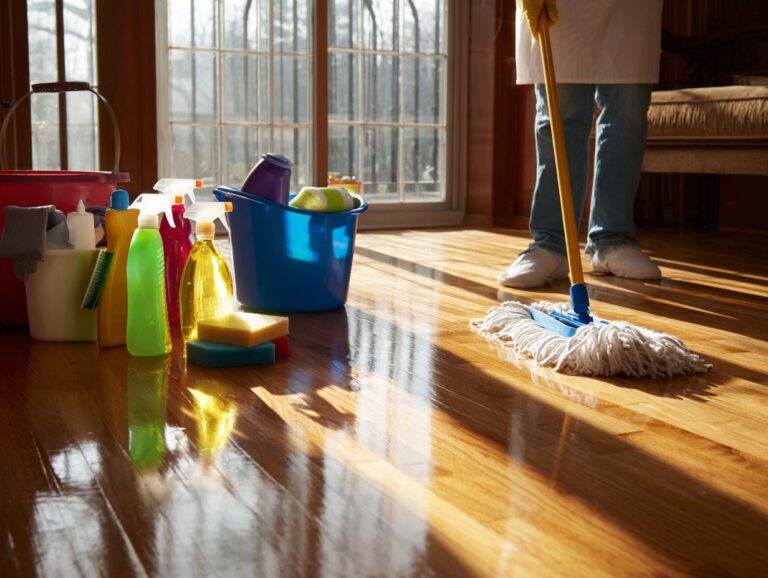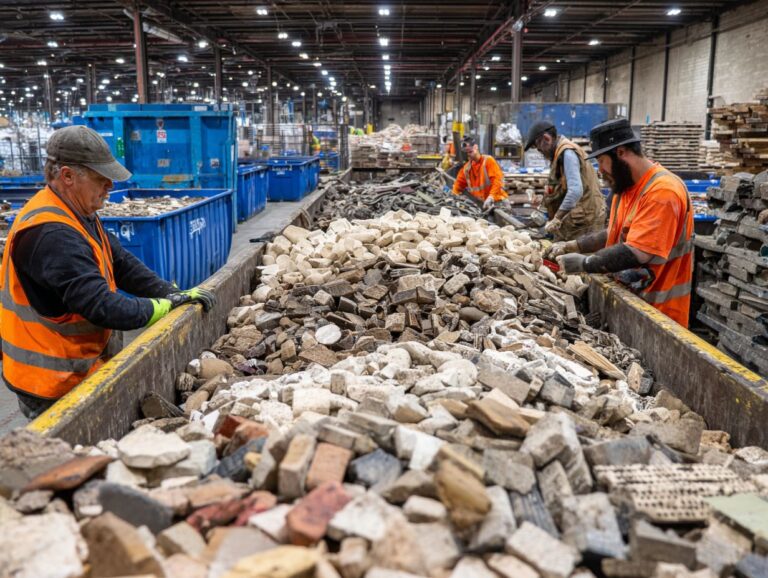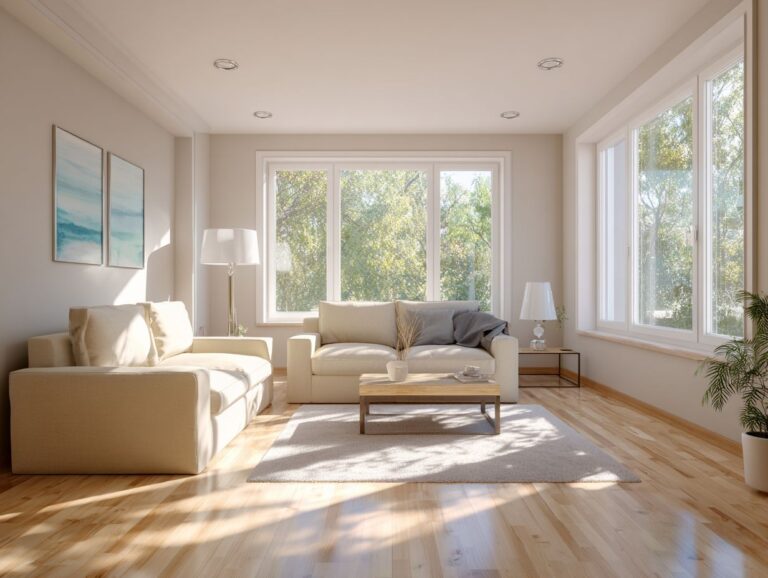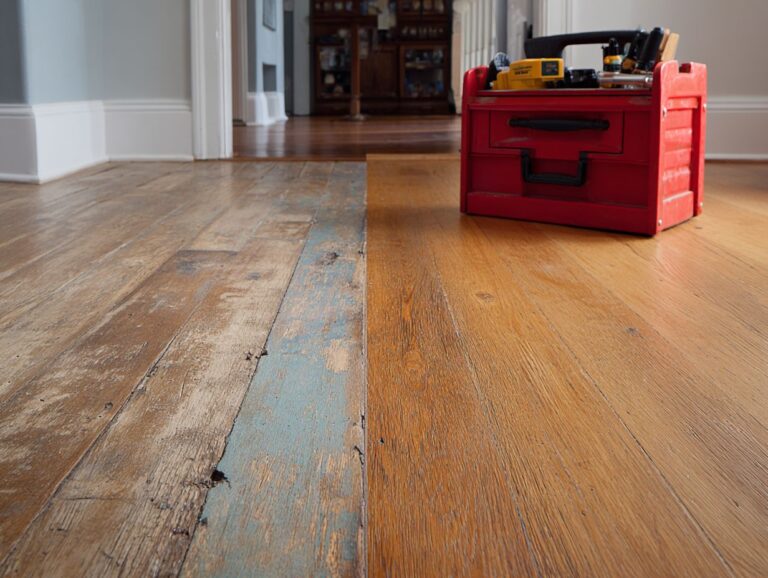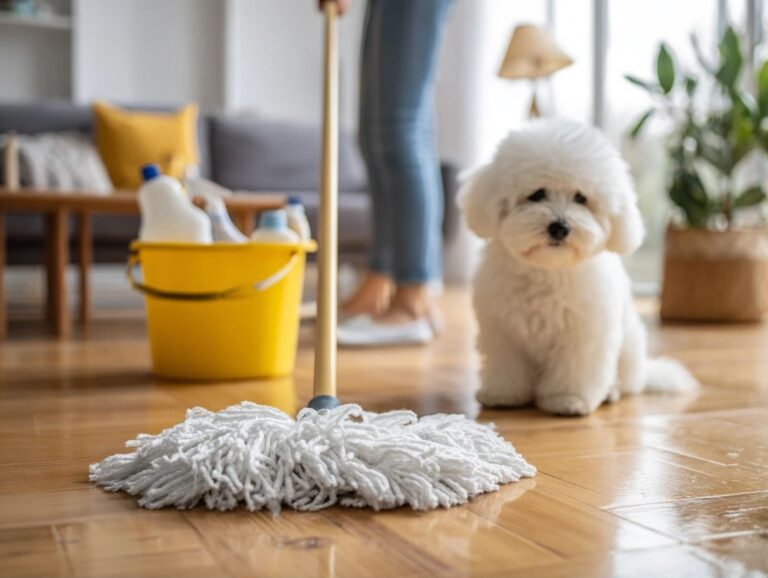Pet Damage to Flooring – Prevention and Repair
Are your beloved pets leaving their mark on your hardwood floors? Pet damage-like scratches from paws and stains from pet urine-can be a homeowner’s nightmare. Knowing how to stop these problems is important for keeping wood floors looking good. This guide will show you practical ways to stop scratches and fix any damage, so your pets and flooring can stay in good condition.
Key Takeaways:
Contents
- Pet Damage Flooring Statistics
- Types of Pet Damage
- Prevention Strategies
- Training Your Pets
- Repairing Pet Damage
- Professional Help vs. DIY
- Long-Term Maintenance
- Frequently Asked Questions
- What are some common causes of pet damage to flooring?
- How can I prevent my pet from damaging my flooring?
- What type of flooring is most resistant to pet damage?
- How can I repair pet damage to my flooring?
- Is it possible to get expert assistance for fixing pet-related damage to my floor?
- Is it possible to prevent my pet from damaging my flooring entirely?
How Pets Affect Flooring
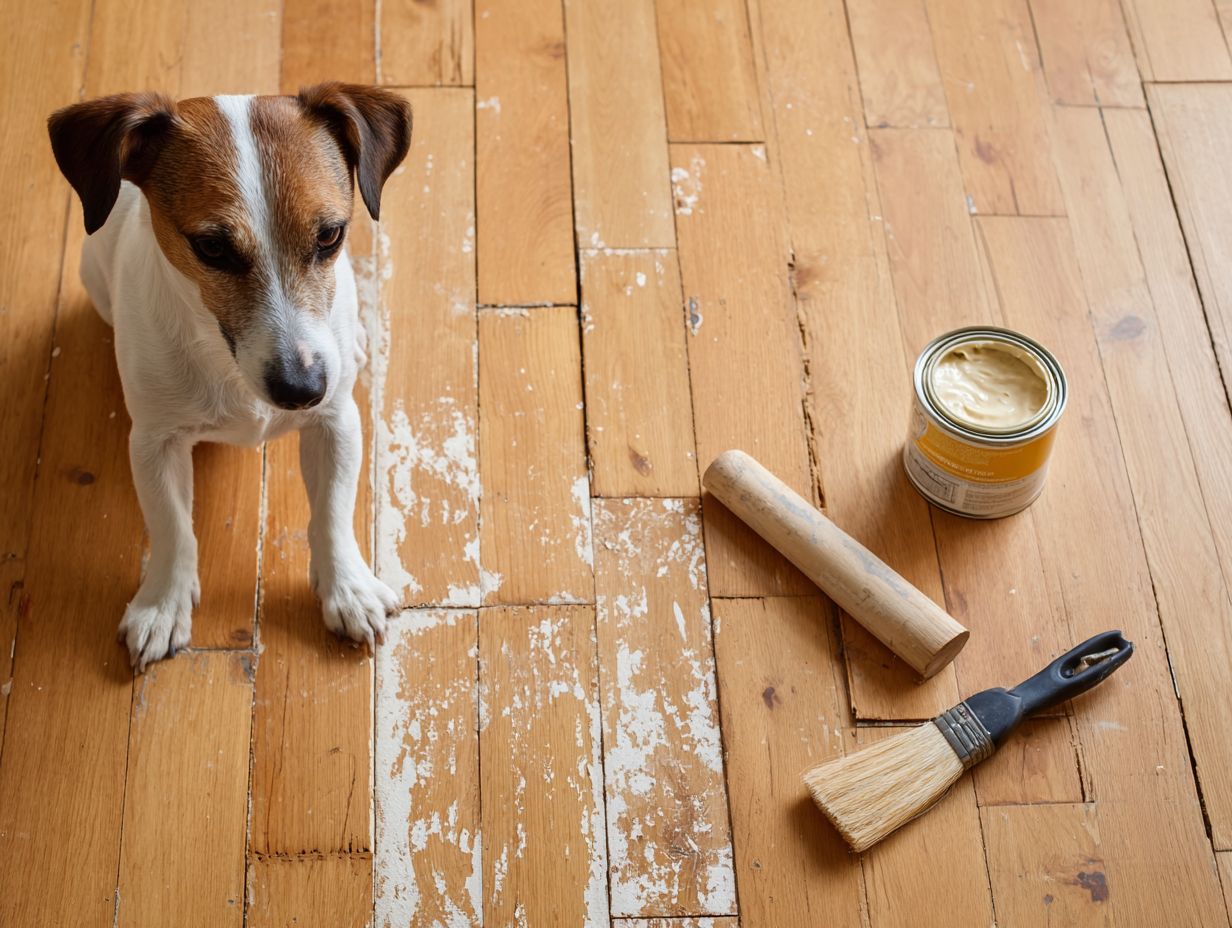
Pets, especially dogs and cats, can lead to various forms of damage to hardwood floors, which can be costly to repair.
According to a survey, 73% of pet owners report damage to their floors, mainly from scratches and stains. Pets often scratch surfaces with their claws, and accidents from animals that aren’t trained can cause noticeable stains.
To mitigate this, consider using area rugs in high-traffic zones, applying protective coatings like polyurethane, or opting for durable flooring alternatives, such as laminate or tile, which are more resistant to damage.
Regularly trimming your pet’s nails can also significantly reduce the risk of scratches. As mentioned in our guide to Common Flooring Installation Mistakes and How to Avoid, choosing the right flooring material is crucial to minimizing potential damage.
Pet Damage Flooring Statistics
Pet Damage Flooring Statistics
Pet-caused Damage and Repair Costs: Percentage of Owners Reporting Damage
Pet-caused Damage and Repair Costs: Repair Costs Over GBP1,000
Pet-caused Damage and Repair Costs: Collective Repair Bills
The Pet Damage Flooring Statistics The report offers a detailed look at how pets impact home floors. It explains how often damage occurs and the costs of repairs for different pet owners. It’s a stark illustration of the financial burden that pet-caused damage can entail, highlighting significant differences across various types of pets.
Pet-caused Damage and Repair Costs indicate that mice owners report the highest percentage of damage at 100%. This suggests that mice may have particularly detrimental effects on flooring. Following closely are rabbit owners at 83%, cat owners at 82%, and lizard owners at 80%, showing that larger or more active pets often cause noticeable wear and tear. Dog owners report damages at 77%, pointing to the potential impact of claws and heavy paw traffic. Gerbil owners, at 75%, guinea pig owners at 64%, and hamster owners at 54%, see progressively less damage, which might be due to their smaller size and confined spaces.
When considering Repair Costs Over GBP1,000, mice owners again face significant expenses, with 50% reporting repair costs exceeding this amount. Pigeon owners, at 20%, may see costs from droppings or nesting behaviors. Only 5% of dog owners and 4% of cat owners report such high repair costs, suggesting that while damage is frequent, it may often be minor.
Collective Repair Bills reveal substantial collective costs, with dog owners bearing GBP348 million and cat owners GBP279 million. These figures highlight the widespread nature of pet-related damage and its financial impact, emphasizing the need for durable flooring solutions for pet owners.
Overall, the data shows how important it is to pick the right flooring for homes with pets to prevent damage and lower repair costs. Knowing these statistics can help pet owners make better choices about preventive care and flooring purchases to manage the impact of their pets.
Common Types of Flooring Affected
Different flooring materials have varying levels of resistance to pet damage, so choosing the right one is important.
When choosing pet-friendly flooring, consider hardwood, laminate, and tile.
Hardwood, costing $5-$15 per square foot, is beautiful but can scratch easily. Opt for tougher species like oak or hickory for better durability.
Meanwhile, laminate offers a budget-friendly choice, around $1-$5 per square foot, and resists scratches better than hardwood. Make sure it is a good product to prevent water damage.
Tile is very resistant to stains and scratches (costing about $3-$15 per square foot), so it’s great for homes with busy pets, but it can feel cold on your feet.
Types of Pet Damage
Pets can create different kinds of damage, and each type needs specific methods for stopping and fixing it.
Scratches and Scuff Marks
Scratches and scuff marks on wood floors can detract from their beauty and require specific remedies to restore their appearance.
-
To tackle minor scratches, first clean the affected area with a damp cloth.
-
For superficial scratches, a wood filler ($10-$20) can effectively fill in the imperfections.
-
For deeper blemishes, consider using a polyurethane sealant ($20-$50) to create a protective layer. After applying the sealant, let it dry completely before walking on the surface.
-
For recurring issues, help prevent scratches by trimming your pets’ nails regularly and using protective pads under furniture legs.
Following these steps will make your wood flooring last longer.
Stains and Odors

Urine from pets can damage hardwood floors and cause lasting smells if not cleaned quickly.
To effectively tackle these stains, begin by blotting the area with paper towels to absorb excess liquid.
Next, mix a solution of equal parts white vinegar and water, which helps neutralize odors.
For more stubborn stains, apply hydrogen peroxide directly on the affected area and let it sit for about 30 minutes before blotting it dry.
Consider using enzymatic cleaners, such as Nature’s Miracle ($10-$30), which break down urine proteins effectively. Test the cleaner on a hidden spot first to check it won’t cause any damage before using it on bigger areas.
Water Damage from Accidents
Accidental spills and pet urine can lead to significant water damage, which, if not addressed quickly, can compromise the entire flooring structure.
To mitigate water damage, start by blotting the affected area with absorbent towels to soak up as much moisture as possible. If the area is large, consider using a wet/dry vacuum for efficiency.
Afterwards, set up fans to move air around and quicken drying; using a dehumidifier can lower moisture levels.
If you notice warping or discoloration that persists, it may be time to consult professional hardwood restoration services to assess the damage thoroughly and suggest suitable repairs.
Prevention Strategies
Stopping pets from damaging your home involves picking suitable flooring and using ways to protect it. Curious about common flooring installation mistakes? Our guide highlights what you need to know to keep your floors pet-friendly.
Selecting Durable Flooring Options
Opting for durable flooring materials can significantly reduce the risk of damage caused by energetic pets.
Consider laminate, engineered wood, and vinyl for pet-friendly flooring.
-
Laminate, like the quick-install options from Pergo, provides scratch resistance and typically ranges from $1 to $3 per square foot.
-
Engineered wood, such as Mohawk’s durable options, offers better moisture resistance, priced around $3 to $7 per square foot.
-
Vinyl, exemplified by luxury brands like Karndean, stands out for its waterproof features and can cost $2 to $5 per square foot.
Each type balances aesthetics with practicality, ensuring your space remains safe and stylish.
Using Protective Covers and Rugs
Using protective mats and rugs in high-traffic areas can serve as a first line of defense against pet-related damage.
To maximize effectiveness, consider indoor/outdoor rugs made from polypropylene, priced between $30 and $100. These rugs don’t absorb water and are easy to clean, making them perfect for areas where spills or dirt are common.
Position them near entryways and under pet feeding stations to catch debris before it spreads. For additional protection, use washable cotton mats in living areas. These can be thrown in the washing machine, ensuring you maintain a fresh and clean environment with minimal effort.
Combining these strategies will greatly prolong the life of your flooring.
Regular Grooming and Maintenance
Regular grooming and maintenance can dramatically minimize the likelihood of scratches from pets, contributing to floor longevity.
To maintain your floors effectively, establish a routine grooming schedule for your pets. Trim their nails every month to prevent scratches since long nails can damage floors.
Brush your pets weekly to reduce shedding and dander, which can create a build-up on the floor. Consider using a vacuum designed for pet hair, such as a Shark Navigator, to keep your floors clean between grooming sessions.
Check the state of your floors twice a year, fixing small problems quickly to prevent bigger ones later.
Training Your Pets
Teaching pets to act in certain ways can greatly decrease the chance of them damaging your floors.
Establishing Designated Areas
Creating designated areas for play and rest can help keep your flooring protected from scratches and stains.
- Start by selecting pet-friendly flooring options like vinyl, cork, or laminate, which are durable and easy to clean.
Use baby gates or pet barriers to define these spaces. Make sure there are cozy beds and toys in the space to create a friendly atmosphere.
Positive reinforcement is essential; reward your pets when they stay within the designated spots to encourage this behavior.
With patience and consistency, your pets will learn their boundaries while keeping your home safe from damage.
Positive Reinforcement Techniques
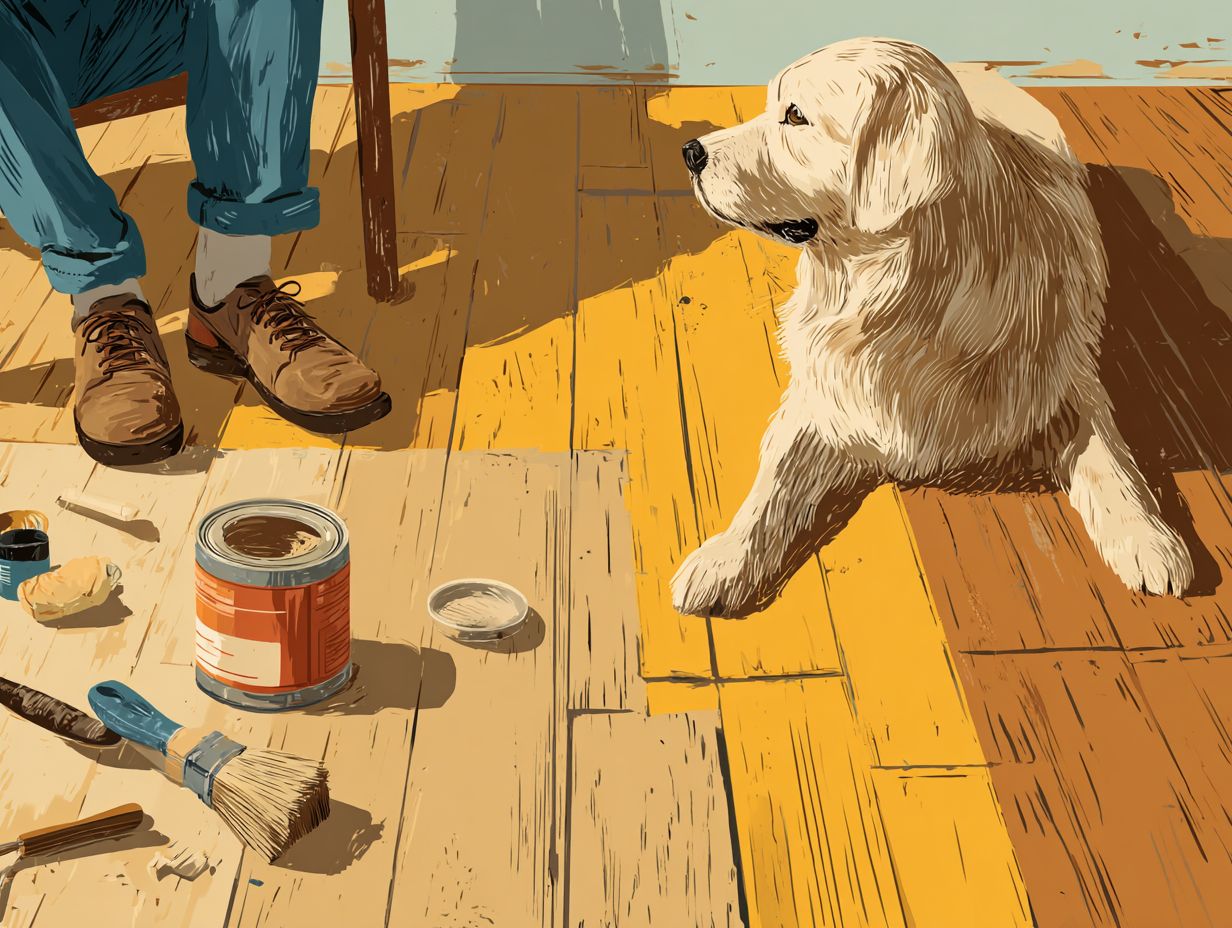
Utilizing positive reinforcement can effectively train pets to avoid damaging actions, promoting better behavior and floor care.
To implement this, start by using small, tasty treats to reward your pet immediately after they do something positive, like using their designated bathroom area.
Pair the treat with verbal praise, such as `good job!’ to reinforce the message. Regularly address the behavior each time it occurs.
For example, if your dog goes outside to relieve itself, reward them each time to encourage this action. Over time, this will help minimize accidents on your flooring, leading to a cleaner and more harmonious home.
Repairing Pet Damage
Fixing damage from pets quickly can make your floor look good again and stop more problems from happening. For comprehensive guidance on how to effectively repair and prepare your floor, consider exploring our Subfloor Preparation – Leveling and Repair Guide.
Assessing the Extent of Damage
Properly assessing the extent of damage is essential before proceeding with repairs, as it dictates the required approach.
- Begin your assessment by creating a checklist to categorize the damage. Look for surface scratches, which can often be polished out, and deeper gouges that may require sanding or filler.
- Inspect the affected area for structural issues; any cracks may need professional evaluation. Consider whether the damage affects functionality or aesthetics.
- If you find a lot of damage or don’t know the best way to fix it, it’s a good idea to ask a professional to make sure it is repaired correctly.
Repairing Scratches on Wood Flooring
Scratches on wood flooring can often be repaired easily with the right techniques and tools.
Start by cleaning the scratched area with a soft cloth to remove debris.
For shallow scratches, apply a wood filler that matches your floor, such as Minwax Wood Fill ($10-$15). Use a putty knife to spread it evenly and let it dry according to package instructions.
For deeper scratches, sand the area lightly and then replenish it with a stain that closely matches your floor. After applying the stain, blend it with the surrounding wood using a clean cloth. Finish with a clear coat for added protection.
Removing Stains from Carpets
It’s important to clean carpet stains immediately to stop them from causing lasting harm and bad smells.
To effectively remove stains, start by blotting the area with a clean cloth to absorb excess liquid.
For a DIY solution, mix equal parts white vinegar and water in a spray bottle. Lightly spray the mixture on the stain and let it sit for 5-10 minutes.
Blot with a cloth until the stain lifts. If the stain persists, consider using a commercial pet stain remover like Nature’s Miracle ($10-$25), which can break down organic stains.
Always test any solution on a hidden area first to avoid discoloration.
Dealing with Water Damage
If not quickly handled, pet accidents can cause serious water damage.
- Start by assessing the affected area. Determine how far the water has spread and identify any structural damage.
- Use a moisture meter to check hidden dampness in walls and floors. Next, employ drying techniques such as running dehumidifiers and fans to expedite moisture removal.
- For tough smells or stains, think about using special cleaning products like enzymatic cleaners that break down pet urine elements.
- If there is significant damage, you may need to contact a professional restoration service to repair everything and stop mold from growing.
Professional Help vs. DIY
Choosing between doing the repairs yourself or hiring an expert can affect how well your flooring repairs turn out.
When to Call a Professional
Some damage might require a professional to get the best outcome and prevent more problems.
For instance, extensive water damage often leads to structural problems that DIY methods can’t effectively address. The cost of hiring a restoration service can range from $1,000 to $5,000 based on how serious the damage is.
Similarly, deep gouges in hardwood floors can require refinishing, estimated at $2 to $5 per square foot.
If you’re unsure about your DIY skills or the potential extent of damage, consult contractors through platforms like Angie’s List or HomeAdvisor. They can check the situation and let you know if you need a professional before beginning repairs.
DIY Repair Techniques
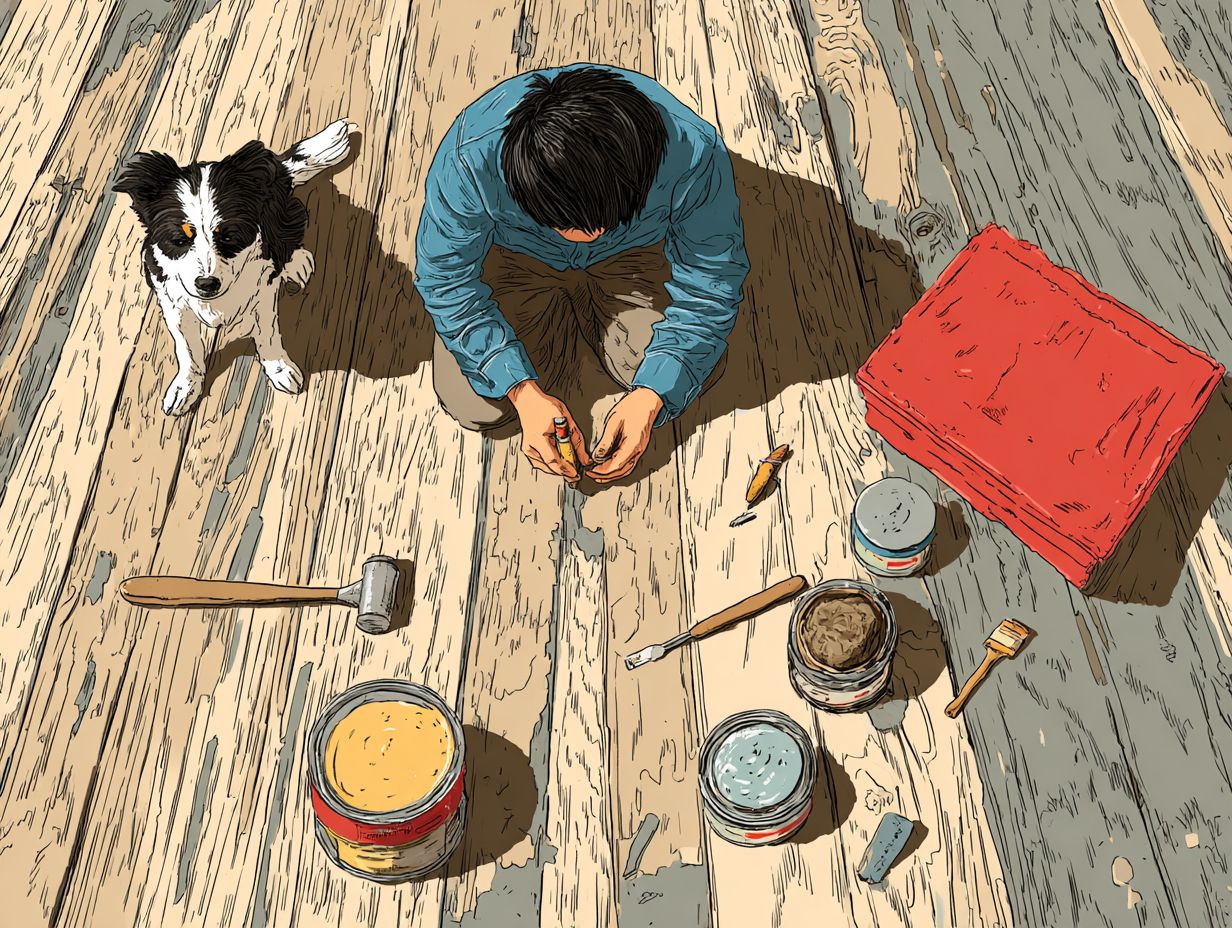
Many minor pet-related damages can be effectively addressed using simple DIY techniques and readily available materials.
-
For scratches, use a wood filler to fill gaps, then sand and finish the surface.
-
Stains can often be treated with a stain marker that matches your furniture-application only takes a few minutes and often dries quickly.
-
For water damage, gently dab the area with a mop or cloth and let it air dry to prevent mildew.
As a rule of thumb, each repair should take no more than an hour, with costs typically under $20 for materials. These easy repairs can improve your home without costing a lot.
Long-Term Maintenance
Keeping your hardwood floors in good condition involves cleaning them regularly and maintaining them over time.
Routine Cleaning Practices
Establishing a routine cleaning schedule can help preserve the condition of your hardwood floors despite pet activity.
Start by sweeping your floors weekly to remove dirt and pet hair. This prevents scratches and keeps the surface fresh.
Once a month, use a damp mop with a mixture of vinegar and water-it’s effective for removing residue without damaging the finish.
To thoroughly clean, plan a thorough cleaning every three months with products specifically for hardwood.
Create a simple schedule:
- Week 1-sweep;
- Week 4-mop;
- Month 3-deep clean.
This approach maintains your floors’ beauty and longevity.
Periodic Inspections and Touch-ups
Carrying out periodic inspections can help catch minor issues before they escalate into costly repairs.
To make sure you perform thorough inspections, follow this checklist:
- Examine surfaces for scratches and stains that may indicate damage.
- Check for signs of wear, including loose fittings or peeling finishes.
- Evaluate any hardware for rust or corrosion.
After identifying these issues, consider touch-up techniques such as applying a fresh coat of polyurethane sealant annually. This preventive maintenance helps preserve your investment, keeping surfaces pristine and extending their life.
Inspect twice a year for optimal results.
Frequently Asked Questions
What are some common causes of pet damage to flooring?
Scratching, chewing, and accidents are the most common causes of pet damage to flooring.
How can I prevent my pet from damaging my flooring?
One way to prevent damage is by keeping your pet’s nails trimmed to minimize scratching. You can also provide designated chew toys and potty train your pet to prevent accidents.
What type of flooring is most resistant to pet damage?
Vinyl, tile, and laminate are the most resistant types of flooring for pets. They last a long time and are simple to clean, so they are less likely to get damaged by pets.
How can I repair pet damage to my flooring?
For scratches, use a wood filler or wax crayon in a matching color. For chewed spots, use a wood patching compound and sand it down before staining to match the rest of the flooring. For accidents, blot the spot with a paper towel and use an enzymatic cleaner to remove any lingering odor.
Yes, you can hire a professional flooring repair service. They have the experience and tools to effectively repair pet damage and restore your flooring to its original condition.
Is it possible to prevent my pet from damaging my flooring entirely?
While complete prevention may not be possible, you can take certain measures such as using area rugs and mats, applying pet-safe floor sealants, and training your pet to minimize damage and prolong the lifespan of your flooring.
